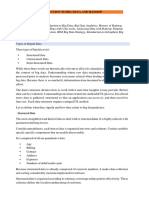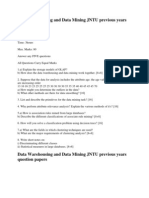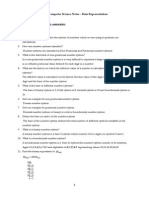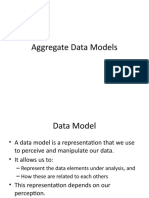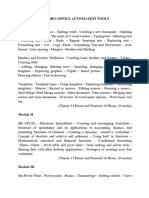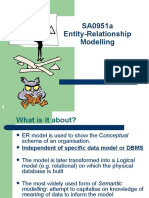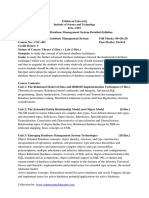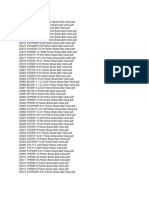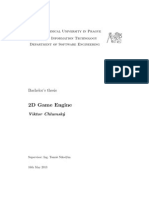50%(2)50% found this document useful (2 votes)
11K viewsData Science Download Syllabus PDF
Data Science Course in Pune is associate Degree knowledge domain field that uses scientific strategies, processes, algorithms and systems to extract information and insights from information in numerous forms, each structured and unstructured, just like data processing.
Uploaded by
shubham phulariCopyright
© © All Rights Reserved
Available Formats
Download as PDF, TXT or read online on Scribd
50%(2)50% found this document useful (2 votes)
11K viewsData Science Download Syllabus PDF
Data Science Course in Pune is associate Degree knowledge domain field that uses scientific strategies, processes, algorithms and systems to extract information and insights from information in numerous forms, each structured and unstructured, just like data processing.
Uploaded by
shubham phulariCopyright
© © All Rights Reserved
Available Formats
Download as PDF, TXT or read online on Scribd
You are on page 1/ 6
DATA SCIENCE
Introduction to Data Science, Use cases, Need of Business
Analytics, Data Science Life Cycle, Different tools available for
Data Science.
1) R Programming
1.1 Introduction to R
1.2 Installation of R
-Windows Installation
-Linux Installation
Installing R and R-Studio, R packages, R Operators,
if statements and loops (for,while, repeat, break,
next), switch case
1.3 Types of Datatype
-Arrays
-Data Frames
-Lists
-Factors
R Data Structure (Vector, Scalar, Matrices, Array, Data
frame, List), Functions, Apply Functions
1.4 Types of Variables
1.5 Types of Operators
-Arithmetic operator
-Logical Operator
-Relational Operator
1.6 Types of control statements:
-If statement
-If else statement
-if else if statement
-switch statement
1.7 Types of Loops :
-for loop
-while loop
-nested loop
1.8 Function Declaration
-Function declaration with parameters
-Function declaration without parameters
1.9 R Data Interface
1.10 R Charts and Graphs
-Pie Chart
-Bar chart
-Line graph
1.11 R statistics
Terminologies of Statistics ,Measures of Centres,
Measures of Spread, Probability, Normal Distribution,
Binary Distribution
1.12 Machine learning algorithms
-classification
the act or process of classifying
-clustering
form a cluster or clusters.
-regression
a return to a former or less developed state.
2)PYTHON
1.1 Introduction to Python
-What is Python and history of Python?
-Unique features of Python
-Python-2 and Python-3 differences
-Install Python and Environment Setup
-First Python Program
-Python Identifiers, Keywords and Indentation
-Comments and document interlude in Python
-Command line arguments
-Getting User Input
-Python Data Types
-What are variables?
-Python Core objects and Functions
-Number and Maths
-Week 1 Assignments
1.2 List, Ranges & Tuples in Python
-Introduction to list, tuples, ranges
-Lists in Python
- More About Lists
-Understanding Iterators
-Generators,Comprehensions and Lambda
Expressions
- Introduction to generators,yields
-Generators and Yield
-Next and Ranges
-Understanding and using Ranges
-More About Ranges
-Ordered Sets with tuples
1.3 Python Dictionaries and Sets
-Introducing to the section
-Python Dictionaries
-More on Dictionaries
- Introducing to Sets
-Python Sets Examples
1.4 Input and Output in Python
-Reading and writing text files
-writing Text Files
-Appending to Files and Challenge
-Writing Binary Files Manually
-Using Pickle to Write Binary Files
1.5 Python built in function
-Python packages functions(Numpy,Pandas,Scipy)
-Defining and calling Function
-The anonymous Functions
- Loops and statement in Python
-Python Modules & Packages
1.6 Python Object Oriented
- Formal presentation of object oriented
programming
-Topping up topics like: Abstraction
Encapsulation,
Inheritance,
Polymorphism,
-Creating Classes and Objects
-Accessing attributes
-Built-In Class Attributes
-Destroying Objects
1.7 Python Exceptions Handling
-What is Exception?
-Handling an exception
-try….except…else
-try-finally clause
-Argument of an Exception
-Python Standard Exceptions
-Raising an exceptions
-User-Defined Exceptions
1.8 Machine learning algorithms
-classification
-the act or process of classifying
-clustering form a cluster or clusters.
-regression a return to a former or less
developed state.
You might also like
- Assignment Questions For Group: 1 Short Answer Questions100% (1)Assignment Questions For Group: 1 Short Answer Questions10 pages
- MA7155-Applied Probability and Statistics Question BankNo ratings yetMA7155-Applied Probability and Statistics Question Bank15 pages
- Question Bank: Data Warehousing and Data Mining Semester: VIINo ratings yetQuestion Bank: Data Warehousing and Data Mining Semester: VII4 pages
- Data WareHouse Previous Year Question Paper100% (1)Data WareHouse Previous Year Question Paper10 pages
- Lab Assignment 1 Title: Data Wrangling I: Problem StatementNo ratings yetLab Assignment 1 Title: Data Wrangling I: Problem Statement12 pages
- Iot Levels and Deployment Templates: Device0% (1)Iot Levels and Deployment Templates: Device15 pages
- Topic 2 - Intro To Data Science Machine Learning75% (4)Topic 2 - Intro To Data Science Machine Learning30 pages
- Data Warehousing & Data Mining (R20) Imp Questions:-Unit-1100% (1)Data Warehousing & Data Mining (R20) Imp Questions:-Unit-13 pages
- Knowledge Representation in Data MiningNo ratings yetKnowledge Representation in Data Mining22 pages
- MCA-I SEM - MCA1610-Prog Lab-I-Office Automation Tools-Lab Manual PDF0% (3)MCA-I SEM - MCA1610-Prog Lab-I-Office Automation Tools-Lab Manual PDF52 pages
- Data Warehousing and Data Mining JNTU Previous Years Question PapersNo ratings yetData Warehousing and Data Mining JNTU Previous Years Question Papers4 pages
- PU11 Computer Science Notes - Data Representation50% (2)PU11 Computer Science Notes - Data Representation12 pages
- Lecture 2 Data Structure Array & VectorNo ratings yetLecture 2 Data Structure Array & Vector33 pages
- CS402 Data Mining and Warehousing Question BankNo ratings yetCS402 Data Mining and Warehousing Question Bank6 pages
- Measuring Data Similarity and DissimilarityNo ratings yetMeasuring Data Similarity and Dissimilarity20 pages
- Data Science and Big Data Analysis McqsNo ratings yetData Science and Big Data Analysis Mcqs53 pages
- Write Program in Visual Basic To Display Mark List of A Student50% (14)Write Program in Visual Basic To Display Mark List of A Student2 pages
- Decision Support Systems and Business Intelligence PDF100% (1)Decision Support Systems and Business Intelligence PDF25 pages
- Lecture 2 Part 2 (Hardware and Software in Computer Graphics)No ratings yetLecture 2 Part 2 (Hardware and Software in Computer Graphics)42 pages
- Theory of Automata Unit 1 Handwritten Notes0% (1)Theory of Automata Unit 1 Handwritten Notes20 pages
- Mastering Python: A Comprehensive Guide to ProgrammingFrom EverandMastering Python: A Comprehensive Guide to ProgrammingNo ratings yet
- Introduction To Python Programing: Unit-1No ratings yetIntroduction To Python Programing: Unit-11 page
- Hadoop Development Download Syllabus PDFNo ratings yetHadoop Development Download Syllabus PDF5 pages
- Penerapan Algoritma Convolutional Neural Network Dalam Klasifikasi Telur Ayam Fertil Dan Infertil Berdasarkan Hasil CandlingNo ratings yetPenerapan Algoritma Convolutional Neural Network Dalam Klasifikasi Telur Ayam Fertil Dan Infertil Berdasarkan Hasil Candling9 pages
- CLUT Compression (Slides For CAIP'2019)No ratings yetCLUT Compression (Slides For CAIP'2019)35 pages
- Welcome To Forecasting Using R: Rob J. HyndmanNo ratings yetWelcome To Forecasting Using R: Rob J. Hyndman33 pages
- Anna University Engineering Question BankNo ratings yetAnna University Engineering Question Bank7 pages
- 17.hypothesis Test On Proportion and VarianceNo ratings yet17.hypothesis Test On Proportion and Variance2 pages
- BA004 DCO Methods in Solution Analysis and DesignNo ratings yetBA004 DCO Methods in Solution Analysis and Design1 page
- Assignment Questions For Group: 1 Short Answer QuestionsAssignment Questions For Group: 1 Short Answer Questions
- MA7155-Applied Probability and Statistics Question BankMA7155-Applied Probability and Statistics Question Bank
- Question Bank: Data Warehousing and Data Mining Semester: VIIQuestion Bank: Data Warehousing and Data Mining Semester: VII
- Lab Assignment 1 Title: Data Wrangling I: Problem StatementLab Assignment 1 Title: Data Wrangling I: Problem Statement
- Data Warehousing & Data Mining (R20) Imp Questions:-Unit-1Data Warehousing & Data Mining (R20) Imp Questions:-Unit-1
- MCA-I SEM - MCA1610-Prog Lab-I-Office Automation Tools-Lab Manual PDFMCA-I SEM - MCA1610-Prog Lab-I-Office Automation Tools-Lab Manual PDF
- Data Warehousing and Data Mining JNTU Previous Years Question PapersData Warehousing and Data Mining JNTU Previous Years Question Papers
- Write Program in Visual Basic To Display Mark List of A StudentWrite Program in Visual Basic To Display Mark List of A Student
- Decision Support Systems and Business Intelligence PDFDecision Support Systems and Business Intelligence PDF
- Lecture 2 Part 2 (Hardware and Software in Computer Graphics)Lecture 2 Part 2 (Hardware and Software in Computer Graphics)
- Mastering Python: A Comprehensive Guide to ProgrammingFrom EverandMastering Python: A Comprehensive Guide to Programming
- Penerapan Algoritma Convolutional Neural Network Dalam Klasifikasi Telur Ayam Fertil Dan Infertil Berdasarkan Hasil CandlingPenerapan Algoritma Convolutional Neural Network Dalam Klasifikasi Telur Ayam Fertil Dan Infertil Berdasarkan Hasil Candling























